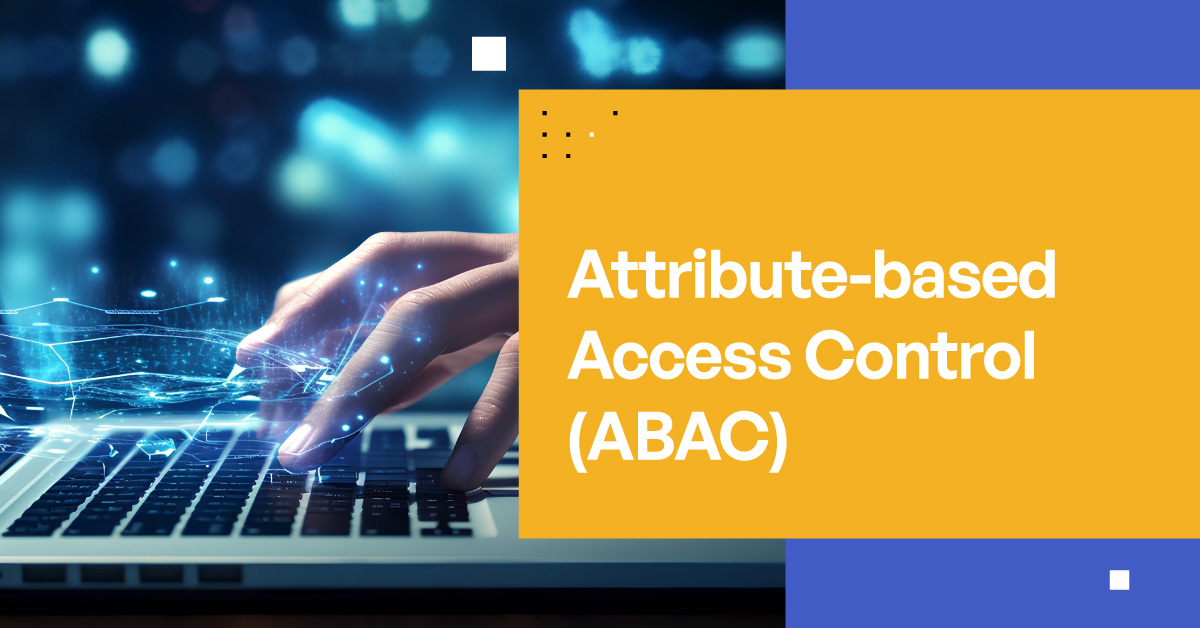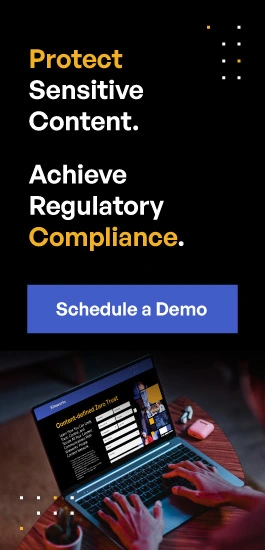What is Attribute-based Access Control?
With sensitive information flowing across multiple systems and users, implementing robust access controls has never been more critical for organizations. Otherwise, unauthorized access can lead to a data breach and compliance violation. These incidents can cost businesses millions of dollars in penalties, fines, legal fees, settlements, and lost revenue. Data breaches in fact cost organizations an average of $4.88 million per incident according to IBM’s 2024 research.
Below we’ll explore attribute-based access control (ABAC), a powerful security framework that’s revolutionizing how organizations protect their most valuable data assets.

Executive Summary
Main Idea: Attribute-based access control (ABAC) is an advanced security model that dynamically grants or denies access to data and resources based on multiple attributes including user characteristics, environmental conditions, and resource properties, offering superior flexibility and granular control compared to traditional role-based systems.
Why You Should Care: ABAC enables organizations to implement zero-trust security principles, reduce data breach risks, ensure regulatory compliance, and adapt access controls in real-time to changing business conditions—making it essential for modern cybersecurity strategies.
Key Takeaways
- ABAC provides dynamic, context-aware access control. Unlike static role-based systems, ABAC evaluates multiple attributes in real-time, including user identity, location, time, and device security status to make intelligent access decisions.
- Superior granularity reduces security risks. ABAC enables fine-grained permissions that ensure users access only the specific data necessary for their tasks, significantly minimizing potential attack surfaces.
- Zero-trust alignment enhances modern security. ABAC naturally supports zero-trust principles by never assuming trust and continuously verifying every access request based on comprehensive attribute evaluation.
- Regulatory compliance becomes manageable. Organizations can more easily meet data protection requirements like GDPR, HIPAA, and CMMC through ABAC’s detailed policy controls and comprehensive audit capabilities.
- Implementation requires strategic planning. Successful ABAC deployment demands thorough attribute definition, policy creation, system integration, and ongoing user training to maximize security benefits.
Understanding Access Control: The Foundation of Data Security
Access control systems form the backbone of organizational data protection, determining who can view, modify, or utilize digital resources. These systems enforce security policies that maintain data confidentiality, integrity, and availability across computing environments.
The Evolution of Access Control Models
Modern organizations rely on several access control frameworks, each designed to address specific security challenges and operational requirements.
Discretionary Access Control (DAC)
DAC places access decisions in the hands of resource owners, allowing them to grant or revoke permissions at their discretion. While flexible, this model can create security vulnerabilities when individual judgment leads to inappropriate access grants.
Mandatory Access Control (MAC)
MAC implements rigid, hierarchical security structures where access decisions are based on fixed security attributes assigned to both users and resources. Government and military organizations often prefer MAC for its strict, policy-driven approach that minimizes human error.
Role-Based Access Control (RBAC)
RBAC simplifies permission management by assigning access rights to organizational roles rather than individual users. This model works well for organizations with stable job functions and clear hierarchical structures.
What is Attribute-Based Access Control (ABAC)?
ABAC represents the next evolution in access control technology, using multiple attributes to make dynamic, context-sensitive access decisions. Unlike traditional models that rely on static roles or fixed security levels, ABAC evaluates a comprehensive set of characteristics before granting or denying access to data and resources.
How ABAC Works: The Attribute Evaluation Process
ABAC systems analyze three primary attribute categories to determine access permissions:
User Attributes
These characteristics define who is requesting access, including identity, job role, department, security clearance level, employment status, and historical access patterns.
Environmental Attributes
ABAC considers the context surrounding access requests, such as time of day, geographic location, network security status, device type, and connection method.
Resource Attributes
The system evaluates properties of the requested data or resources, including classification level, data sensitivity, owner information, and regulatory requirements.
Real-Time Decision Making
ABAC systems process these attributes instantaneously, creating dynamic access policies that adapt to changing conditions without requiring manual intervention. This real-time evaluation ensures that access decisions remain accurate and secure even as organizational circumstances evolve.
ABAC vs RBAC: Understanding the Critical Differences
While both ABAC and RBAC aim to secure organizational data, their approaches differ significantly in flexibility, granularity, and implementation complexity.
RBAC Limitations in Modern Environments
RBAC assigns permissions to predefined roles, making it suitable for organizations with stable job functions and clear hierarchies. However, RBAC’s rigidity creates challenges in dynamic environments where:
- Access requirements change frequently
- Context-dependent permissions are necessary
- Cross-functional collaboration requires flexible access patterns
- Regulatory compliance demands detailed audit trails
ABAC Advantages for Complex Organizations
ABAC addresses RBAC limitations through its attribute-based approach, offering:
- Dynamic Policy Adjustment: Access rights automatically adapt to changing user attributes, environmental conditions, and resource requirements
- Granular Permission Control: Fine-tuned access policies ensure users receive only the minimum privileges necessary for their specific tasks
- Context-Sensitive Security: Environmental factors like location, time, and device security status influence access decisions
- Scalable Implementation: ABAC accommodates organizational growth and changing security requirements without extensive policy restructuring
ABAC vs PBAC: Choosing the Right Framework
Policy-based access control (PBAC) offers another approach to data protection, using comprehensive policies to govern access decisions. Understanding how ABAC and PBAC complement each other helps organizations build robust security frameworks.
Policy-Based Access Control Explained
PBAC implements structured policy frameworks that consider user roles, data characteristics, and access context to determine permissions. While similar to RBAC in considering user roles, PBAC employs more sophisticated policy structures that can evaluate broader attribute sets.
Combining ABAC and PBAC for Maximum Security
Rather than choosing between ABAC and PBAC, organizations often benefit from implementing both models strategically:
- ABAC for Dynamic Environments: Use ABAC where flexibility and real-time attribute evaluation are essential
- PBAC for Stable Policies: Implement PBAC for well-defined, relatively stable access control scenarios
- Integrated Approach: Combine both models to create comprehensive security frameworks that address diverse organizational needs
Implementing ABAC: Security Benefits and Risk Mitigation
ABAC implementation delivers measurable security improvements that directly impact organizational risk profiles and compliance postures.
Enhanced Data Protection Through Fine-Grained Control
ABAC’s granular approach ensures users access only the data necessary for their specific tasks, significantly reducing exposure to:
- Accidental data leaks and misdelivery incidents
- Malicious insider threats and privilege escalation attacks
- External cyberattacks including malware and ransomware
- Unauthorized data access across departments and systems
Supporting Zero-Trust Security Principles
ABAC naturally aligns with zero-trust security models by implementing continuous verification and least-privilege access principles.
Never Trust, Always Verify
ABAC systems evaluate every access request against current attributes, ensuring that trust is never assumed but continuously earned through verification.
Least Privilege Access
By considering multiple attributes simultaneously, ABAC grants the minimum access necessary for users to complete their tasks, reducing potential attack surfaces.
Dynamic Risk Assessment
Environmental attributes enable ABAC to adjust access permissions based on real-time risk factors, such as unusual access locations or times.
Risks of Inadequate Access Control
Organizations that fail to implement robust access control systems like ABAC face significant consequences across multiple areas.
Financial and Legal Implications
- Regulatory Penalties: Non-compliance with data protection standards in healthcare, finance, and other regulated industries results in substantial fines
- Breach Costs: Data breaches from inadequate access controls lead to financial losses, legal liabilities, and remediation expenses
- Business Disruption: Security incidents can halt operations, affecting revenue and customer relationships
Reputational and Competitive Damage
Poor data protection practices erode customer trust, damage brand reputation, and provide competitors with market advantages when security failures become public.
ABAC Implementation Best Practices
Successful ABAC deployment requires strategic planning and ongoing management to maximize security benefits while maintaining operational efficiency.
Planning and Policy Development
Define Comprehensive Attribute Frameworks
Start by cataloging all relevant user, environmental, and resource attributes within your organization. This foundational work ensures your ABAC system can make accurate access decisions across all scenarios.
Create Detailed Access Policies
Develop specific policies that clearly define how attribute combinations should influence access decisions, considering both security requirements and operational needs.
System Integration and Management
Ensure Seamless IT Infrastructure Integration
ABAC systems must integrate smoothly with existing identity and access management (IAM) platforms, security tools, and business applications to avoid operational disruptions.
Implement Continuous Monitoring and Updates
Regularly review and update ABAC policies as organizational structures, data sensitivity levels, and threat landscapes evolve.
Training and Organizational Adoption
Develop Comprehensive User Training Programs
Educate employees about ABAC principles and practices to foster security awareness and ensure policy compliance across the organization.
Establish Clear Governance Procedures
Create processes for requesting access changes, handling exceptions, and maintaining policy consistency as your organization grows and changes.
The Future of Data Protection with ABAC
Attribute-based access control represents a significant advancement in organizational data security, moving beyond traditional role-based limitations to provide dynamic, context-aware protection. By leveraging comprehensive attribute evaluation, ABAC enables organizations to implement zero-trust principles while maintaining operational flexibility.
Organizations implementing ABAC gain not only enhanced security but also improved regulatory compliance, reduced breach risks, and adaptable frameworks that grow with their evolving needs. As cyber threats become more sophisticated and data protection regulations more stringent, ABAC’s flexible, granular approach to access control becomes increasingly essential for maintaining competitive advantage and protecting organizational assets.
The investment in ABAC implementation pays dividends through reduced security incidents, simplified compliance management, and the confidence that comes from knowing your most sensitive data remains protected against evolving threats.
Kiteworks Content–based Risk Policies Enable Account–based Access Control
Attribute–based access control (ABAC) is a sophisticated and comprehensive approach to securing sensitive data and resources within an organization. By leveraging a broad spectrum of attributes to dynamically adjust access permissions, ABAC provides a level of security and flexibility that traditional models such as RBAC cannot match. Its importance in modern cybersecurity strategies is underscored by its ability to mitigate a wide range of risks, from regulatory compliance penalties to reputational damage resulting from data breaches. Adopting ABAC not only enhances security but also ensures compliance with regulatory requirements, making it an invaluable asset in any organization’s security toolkit.
The Kiteworks Private Data Network supports organizations’ zero trust security initiatives by delivering least privilege access. Kiteworks’ approach to access controls extends beyond access to applications. For true risk reduction, protection must be carried through the application to the individual content assets: what content has what risk level, based on its sensitivity, combined with who is sending, receiving, viewing, altering, or saving, from where, and to where. Kiteworks ensures that least privilege is granted to each individual data class and context.
Kiteworks also recognizes organizations cannot protect what they cannot see. By consolidating all third–party communication channels, including: Kiteworks secure email, secure MFT, Kiteworks SFTP, Kiteworks secure file sharing, Kiteworks secure web forms, and other channels, organizations can see who sends what to whom. All file activity is monitored and recorded in comprehensive audit logs in support of zero–trust principles and in adherence to data privacy regulations and standards.
The Kiteworks Private Data Network features FIPS 140-3 Level 1 validated encryption, secure deployment options, automated end-to-end encryption, multi-factor authentication (MFA), and security infrastructure integrations. Together, Kiteworks enables organizations to control, protect, and track every file as it enters and exits the organization.
To learn more about Kiteworks, schedule a custom demo today.
Frequently Asked Questions
Healthcare IT administrators can implement ABAC by defining attributes like user role (doctor, nurse, administrator), patient relationship, location (specific ward/department), and time of access. ABAC ensures doctors access only their patients’ records while allowing emergency personnel broader access during critical situations, protecting patients’ personally identifiable and protected health information (PII/PHI) in compliance with HIPAA while preserving clinical workflow efficiency.
ABAC is generally better for financial services organizations because it evaluates multiple real-time attributes beyond job roles, including location, time, device security, and transaction context. While RBAC assigns static permissions to roles like “loan officer,” ABAC dynamically adjusts access based on customer relationships, geographic restrictions, and regulatory compliance requirements, providing superior fraud protection and compliance management.
ABAC helps small businesses achieve zero trust security by automating access decisions based on predefined attributes, reducing manual permission management. Modern ABAC solutions integrate with existing systems and cloud platforms, allowing small IT teams to implement sophisticated security controls without extensive infrastructure investments or specialized expertise.
Yes, manufacturing companies can use ABAC to create granular policies that allow external partners access to specific project data based on contract attributes, NDAs, and project involvement levels. ABAC considers partner company identity, project phase, and data classification to enable secure collaboration while protecting proprietary designs and manufacturing processes.
When switching from RBAC to ABAC systems, you should expect challenges including comprehensive attribute mapping, policy migration complexity, user training requirements, and system integration testing. The transition typically requires 6-12 months of planning, with initial focus on high-risk data categories before expanding to organization-wide implementation, ensuring minimal business disruption during the migration process.

